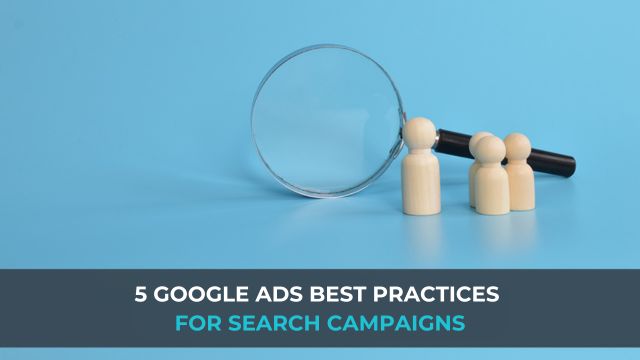Contact Us
Send Us a Message
Need expertise and innovation on your project? Our team can help.
New to the Google Ad space? Getting ready to launch your first Search Campaign? Here are five simple ways to help ensure strong campaign performance.
Table of Contents
What are Google Ads Search Campaigns?
When someone looks for a product or service on Google, a Search Campaign allows businesses to advertise their products or services to the user by showing their product or service ad at the top of the listings. This option is ideal for businesses that want to increase online sales, generate leads, and drive website traffic.
5 Google Search Ads Best Practices
For your Search Campaign to be as successful as possible, these five paid search ads best practices are crucial:
Perform Keyword Research
Keyword research determines the words and phrases your target audience uses to find your products or services. Utilize Google Ads’ built-in Keyword Planner to find keywords that are both relevant to your business and show monthly search volume.
Google will provide keyword variations based on your initial base terms inserted into the Keyword Planner. It will then be up to you, the advertiser, to identify which terms align with your overall goals and are worth bidding on.
Write Engaging Copy
Your ad copy should align with your overall marketing strategy and branding. Keep it short, specific, and direct.
Search Campaigns utilize Responsive Search Ads, which consist of up to 15 headlines and four descriptions, with each element having character limits. This means you only have a short amount of word space to capture a customer’s attention. Make it count!
Your headlines should be a mix of keywords you’re bidding on, awards, benefits of working with your business, and any company slogans.
Another important element that should be incorporated into both headlines and descriptions is your call to action, or CTA. The CTA directs consumers to perform a specific action, like “Purchase Now,” “Sign Up Today,” or “Learn More.”
Use the Right Landing Page
The landing page is the webpage you send customers to when they interact with your ad.
To maximize conversions, the landing page should be relevant to the ad copy. For example, don’t point a bicycle ad to a landing page for helmets. Those items are related, but helmets aren’t what the users were looking for when they clicked.
Similarly, the landing page should reflect the same tone, voice, and branding as the ad itself so the customer knows they’re in the right place. Like the ad copy, your landing page should include calls to action to direct the visitor to a desired action.
Make everything clear and easy to navigate so that your visitor will convert to a customer. Utilize Google’s Best Practices for Landing Pages to help develop an optimized landing page. Consider integrating a Performance max campaign to further enhance your strategy.
Track Conversions
Google Ads conversion tracking measures the conversion rate of your ads and helps determine the overall return on investment. Conversion tracking also helps measure cost-per-conversion, conversion rate, and conversion value if you run an e-commerce shop. The simplest way to set up your Google Ads conversions is to create them within the Ads platform and add them to the site through Google Tag Manager (steps are provided at conversion creation).
In addition, if you want to analyze more user information once they find your website, you can connect Google Ads to your Google Analytics account. This will allow you to observe additional actions made by users on your site, and compare your Search campaigns to other online outlets such as Organic Search and Social Media.
Make Adjustments Based on Data
The key to a successful Google Ads Search Campaign is being able to analyze your data and make adjustments based on results. Negative keywords and consistent A/B testing are two of the best ways to continuously enhance your campaigns.
Negative keywords are the simplest way to help ensure your ad dollars are being spent wisely. They exclude specific terms from showing up in your campaign searches. For example, a T-shirt company would add a negative keyword like “jeans” or “hats” since they only sell T-shirts and would want to avoid showing their ad to users searching for jeans or hats.
A/B testing ad copy is the only way to see which messaging resonates with your audience the best. By creating at least two variations of ads, you can gather data for them and then pinpoint which generates the overall highest conversion rate. Based on the results, you can continuously create new A/B tests and improve your campaign’s overall performance over time.
Utilize a Google Ads Management Service
With so many moving parts working together to maximize your Search Campaign, it can be overwhelming to monitor it on your own. If you’re struggling to keep up with it or would rather rely on Google Ads experts, consider availing expert digital marketing services. At Techark, we aid with Search Campaigns and offer Google Ads management services in the Virginia Beach area, and beyond.
Don’t leave your campaign’s performance up to chance; optimize it and get the greatest possible return on investment with help from TechArk.
Learn how our digital marketing agency in Virginia Beach can help improve your campaigns. Call us at (757) 776-7762 or set up an appointment to talk with a specialist today.



